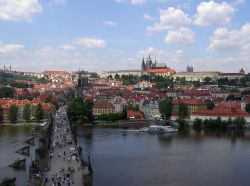
Experts: Prague Lacks a Concept for the Future of the Heritage Reserve
 |
Experts also agree that the declaration of the Prague Monument Reserve 40 years ago significantly benefited historical buildings. Many of them were saved, and the character of the city was preserved as well.
The historical core of Prague was declared a monument reserve on July 21, 1971. With an area of 866 hectares, it is one of the largest monument zones in the world.
According to those working in monument protection, the declaration of the reserve was undoubtedly a positive act. "It had epoch-making significance," said Richard Biegel from the Club for Old Prague to ČTK.
Josef Štulc, president of the Czech section of ICOMOS (International Council on Monuments and Sites), agrees with him. Thanks to the monument zone, according to him, the communist regime did not resort to widespread demolitions. For example, monument preservationists managed to prevent the construction of a gigantic hospital at Karlov and the building of the Malostranský tunnel, which would have required the demolition of many buildings in Kampa and Malá Strana.
However, some experts criticize the current situation in monument protection. They are particularly unhappy with the work of city hall officials, who recently permitted, for example, the demolition of a building at the corner of Wenceslas Square and Opletalova Street. "The advisory board very often decides under the influence of investors' opinions, because it includes experts, but many of them work as architects or draftsmen of historical building surveys for those investors," emphasized Kateřina Bečková from the Club for Old Prague.
Štulc points out that Prague primarily lacks a regulation on construction activities in the monument reserve, which was abolished in the 1990s. "It is evident that the city hall prefers when its officials decide on each case and are not bound by any regulation," he noted, adding that deciding on construction activities is a "gold mine." He would also reintroduce the position of the city’s chief architect, and regulatory plans, or "rules of the game for investments," should be developed, according to him.
Biegel also criticizes the lack of regulation. According to him, Prague lacks an institution that would evaluate the existing experiences with the monument reserve. Its future direction, in his view, should be set by professional discussion.
The director of the Prague branch of the National Heritage Institute, Michael Zachař, is satisfied with the state of monument protection. "I am not complaining. Even though we are subjected to criticism that Prague is poorly protected, I think that's not the case," he told ČTK. "But it is right to talk about it. Discussions are ongoing, and no one is hindering it," he added. Jan Kněžínek, the head of Prague's heritage protectors, also shows satisfaction. "We don't even notice it that much, but a foreigner who came in the early 90s and now talks about it as a miracle," he said about the city's restoration. According to him, a few things did not work out, such as the demolition of the Těšnov Railway Station. He also considers the number of cars in the historic alleys to be an "enormous backlog."
Experts agree that modern architecture belongs in historic urban settings. They consider the tunnel under the ramparts of the Powder Bridge, the Langhans building on Vodičková Street, or the Dancing House on Rašínovo nábřeží to be gentle interventions into the city's architecture. Conversely, they disapprove of the reconstruction of some shopping centers, the congested road or the transportation company dispatch center at Na Bojišti.
The English translation is powered by AI tool. Switch to Czech to view the original text source.
0 comments
add comment











